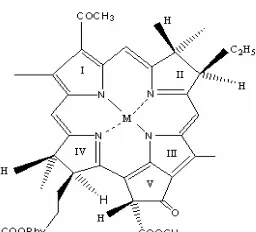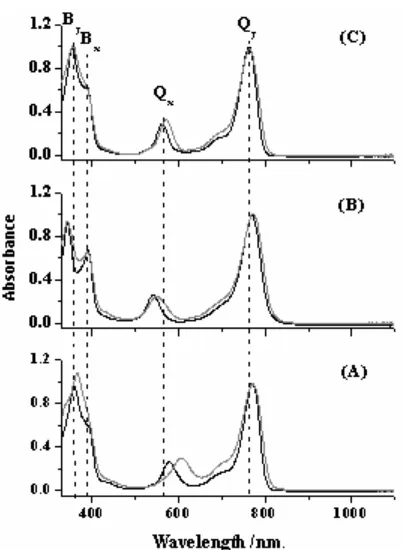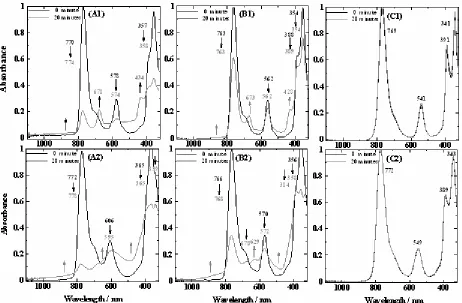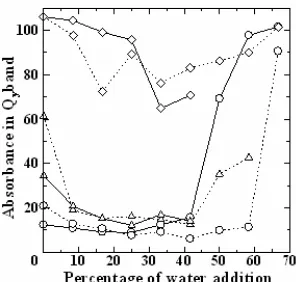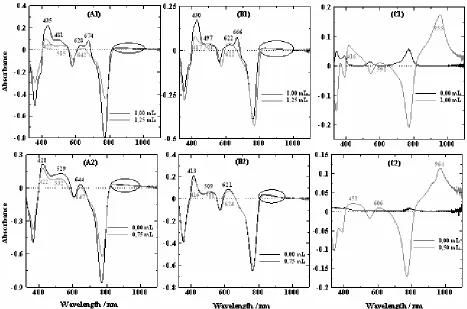PHOTOSTABILITY OF BACTERIOCHLOROPHYLL
a
AND ITS DERIVATIVES AS
POTENTIAL SENSITIZERS FOR PHOTODYNAMIC CANCER THERAPY:
THE STUDY ON ACETONE-WATER AND
METHANOL-WATER SOLVENTS
Leenawaty Limantara
1.2.*and Heriyanto
2 1Industrial Engineering Study Program of Ma Chung University 2
Ma Chung Research Center for Photosynthetic Pigments, Ma Chung University,
Jl. Villa Puncak Tidar N-01,Malang 65151, East Java, Indonesia
Received October 26, 2011; Accepted May 9, 2011
ABSTRACT
The determination of photostability for Mg-BChl a, Zn-BPheo a and Cu-BPheo a irradiated with red light (≥630 nm, 870 lux) and equilibrated with air for 20 min in acetone-water and methanol-water solvents at various percentages of water has been done. The presence of light and oxygen in the pigment solution cause the pigment instable. The pigment stability toward photooxidation is extremely influenced by solvent properties, including oxidation potential value and solvent abilities to form coordination and aggregate. Degradation products of pigment during irradiation treatment can be detected by increment of absorption at the absorption spectrum or occurrence of new positive absorption bands at the different absorption spectra. Cu-BPheo a is a promising photosensitizer based on its stability toward photooxidation in acetone-water solvents.
Keywords:Photostability, bacteriochlorophyll a and its derivatives, acetone-water, methanol-water
INTRODUCTION
Bacteriochlorophyll (BChl) a is a bacteriochlorin-type chlorophyll which is the most widely distributed. It is present in the reaction center (RC) and the core-antennas of most anoxygenic bacteria, as well as in the peripheral antennas of the purple bacteria [1-3]. As chlorophylls (Chls), generally, BChls have several functions in photosynthesis, such as: the light harvesting, transferring the excitation energy into RC and the primary charge separation crosses photosynthetic membranes [3-4]. The molecular structure of BChl a contains one of Magnesium (Mg) atoms in the center of its macrocycle where the central Mg atom coordinates with four pyrrole rings (Fig. 1).
In recent decades, there has been a growing interest in the use of BChl a and its derivatives in medical field by giving consideration for photophysical and photochemical properties as efficient and promising sensitizers in photodynamic therapy known as Photodynamic Therapy (PDT) [5-7]. PDT is a cancer therapy that requires a joint action of a photosensitizer, light, and oxygen [8]. PDT uses the toxic of reactive oxygen species (ROS) produced from photosensitizer and combined with light energy to attack and destroy the cancer tissue. BChl a has a relatively higher molar extinction coefficient at the near-infrared wavelength
(λmax = 760-780 nm,ε = 4-10 × 10 4
M-1cm-1), therefore the light penetration into the tissue becomes maximum
[9-10] and the triplet energy is still high [11] for generating ROS [12-13].
Insolubility of BChl a in the water restricts its usage for PDT. Therefore, the chemical modifications of BChl a are necessary to carry out through modification of substituents or to replace the center Mg atom. These chemical modifications can enhance their solubility, their capacity to form ROS, their ability to attain and bind specifically cancer tissue rather than normal tissue [14-15]; replacement of metals in BChl can also change the redox potential of macrocycle and the transition energy of electron [16-17]. Fiedor et al. [18] have been successful in making a water-soluble BChl through esterification with a polar amino acid as serine methyl ester. Early investigation showed that 173 ester between bacteriochlorophyllide a and serine methyl ester (BPheide-ser) as a promising sensitizer for PDT compared with BChl. This result was considered to be the basic investigation of photophysical for this new molecule [19-20].
Fig 1. Chemical Structure of Mg-BChl a, Zn-BPheo a, and Cu-BPheoa. M = Mg, Cu, Zn
of solvents, such as formamide-water, methanol-water, and acetone-water [22-30]. The two types of solvent system are intended to produce hydrogen bonds to resemble an in vivo condition of hydrogen bonds of peptide moiety in protein [31].
Photostability of sensitizers, depends on their structures (by chemical modification of substituents and central metals) and environments (solvent and in the presence or absence of a quencher) [32-35]. Hence it is interesting to conduct research on the photostability of BChl a and its derivatives as a photosensitizer in two types of solvent systems that are acetone-water and methanol-water. Based on the above background, the purposes of this study are to determine the photostability of BChl a and its derivatives and to identify photodegradation products during irradiation treatment with red light and saturation with air.
EXPERIMENTAL SECTION
Materials
Samples used in this research were pure pigments of Mg-BChl a, Zn-BPhe a and Cu-BPhe a, which were obtained from the chlorophyll laboratory of Ludwig-Maximilian University, Munich, Germany. Acetone, methanol (PA, Merck) and aquadest were used as chemical solvents.
Instrumentation
Absorption spectra of pigments were measured after and before irradiation using a Varian Cary 50, UV-Vis spectrophotometer (Varian, Palo Alto, CA) in the range of 325–1100 nm.
Procedure
Stock Solution of Pigment
Each pigment was dissolved into either acetone or methanol and their absorbance in the maximum absorption of Qyband was adjusted to 1.
Pigment Irradiation (Fiedor et al. [32]; Limantara [33]; Limantara et al. [34] have been modified)
Pigment stability toward the light irradiation and saturation with air was observed with the water addition of a variety of volumes, such as: 0.00; 0.25; 0.50; 0.75; 1.00; 1.25; 1.50; 1.75; 2.00 mL, into the stock solution of pigment with the result that the total volume of solution became 3 mL or the water percentage added into pigment solution is 0.00%; 8.33%; 16.67%; 25.00%; 33.33%; 41.67%; 50.00%; 58.33%; and 66.67%. Pigment solution was stirred by using a magnetic stirrer in open cuvette and it was irradiated with daylight from the volpi lamp (Intralux 6100) using a
red filter RG 630 (Schott, λ ≥ 630 nm). The light
intensity at the surface of pigment solution was set at 870 lux in room temperature. The exposure periods were 0; 0.5; 1; 3; 5; 10; 15 and 20 min.
Data Analysis
Position and absorbance of soret, Qx and Qy bands were analyzed with a Spina 3×23 program (created by Katsumoto, Y., Hiroshima University, Japan).
RESULT AND DISCUSSION
UV-Vis Absorption Spectra
Absorption spectra of Mg-BChla, Zn-BPhea, and Cu-BPhe a in acetone and methanol solvents are shown in Fig. 2. Absorption spectra of Mg-BChl a and its derivatives present four types of absorption bands often called by Qy, Qx, soret or B (Bxand By) in order of increasing their transition energy. These bands demonstrate a characteristic pairwise dependence when the central metal is changed. The By dan Qx transition energies are strongly affected by changing the central metal or adding of the axial ligands that can determine the coordination states. In contrast, weak and indistinct shifts are seen for the Bxdan Qy bands [14]. These results can be monitored when replacing the central Mg metal of BChl a by Cu in acetone solvent, for example, resulted in blue shifts of Qxand By bands as much as 36 nm and 22 nm, respectively, whereas Qyand Bxbands are only shifted below 3 nm. Large shifts of Byand Qxbands and minor shifts for Bx dan Qybands are also seen for the Zn metal.
The four absorption bands can be described in terms of electronic transitions among the two highest filled molecular orbitals and two normally unoccupied orbitals [36]. The strong absorption band of QyMg-BChl
Fig 2. Absorption spectra of BChl a (A), Zn-BPhe a (B) and Cu-BPhea(C) in acetone ( ) and methanol ( ) solvents.
and III. The weaker transition, Qx, in 578 nm and 606 nm is polarized along the perpendicular axis connecting rings II and IV. Two overlapping bands, soret bands, are the stronger energy transitions from Bxband at 391 nm in acetone and methanol solvents and By band at 358 nm and 367 nm in acetone and methanol, respectively.
In vitro studies have revealed that absorption maximum, absorbance, and shape of Mg-BChl a bands depend on solvent polarity [37-38], temperature [39], occurrence of the central Mg atom ligation [40] and aggregation of Mg-BChl [41]. Although all absorption bands reacted to solvent polarity, however, Qx and By bands were reported very sensitive to Mg coordination state [40], while Qy band was very responsive to aggregation of Mg-BChla[42].
Solvent Dependence on the Coordination State
Qxband can be used to distinguish the penta and hexa coordination states of Mg-BChla. The influence of different solvents on Qx band of Mg-BChl a has been related to a change from penta to hexa coordination shown by the existence of one or two axial ligands. In non-polar solvents (carbon tetrachloride), BChl a forms self-aggregation due to interactions between the central Mg atom of one BChl a molecule and the keto C-O group in ring V and acetyl C-O group in ring I of another
BChla molecule. In polar nucleophilic solvents (diethyl ether), BChl a exists as five-coordinate monomeric complexes in which the central atom is penta-coordinated to the four nitrogen (N) atoms of the BChl
a macrocycle ring and one solvent molecule, while in stronger nucleophilic solvents (tetrahydrofuran and methanol), BChl a forms hexa-coordinate monomeric complexes in which the central Mg atom is coordinated to two solvent molecules forming an axial ligand on both sides of the macrocycle ring. In both nucleophilic solvents, penta and hexa ligations of the central Mg atom are formed by Mg-O bond [14,30,40,43-46]. When the central Mg atom of BChl a forms hexacoordinate, then the position of Mg atom is parallel in plane of the macrocycle, whereas Mg position is out of plane of the macrocycle if it forms penta-coordination. Coordination states of Mg-BChla and its derivatives in various solvents have been investigated [14, 30]. Heriyanto et al. [30] revealed that according to the position of Qxband, coordination states of Mg-BChl
a in acetone solvent is in penta-coordination, while its hexa-coordination is formed in methanol solvent. Zn-BPheaeither in acetone or in methanol solvents are in penta coordination. Cu-BPheo a in acetone solvents remains in tetra-coordination, while its coordination state in methanol alters to penta- coordination.
Water Effect on Aggregation Process
Fig 3. Absorption spectra of Mg-BChla(A), Zn-BPheoa(B) and Cu-BPheoa(C) in acetone (1) and methanol (2) solvents during 0 and 20 min irradiation treatments with red light and saturated with air.
Central Metal Effect on Photostability
Stability of Mg-BChla and its derivatives against a red light in the solution saturated with air at room temperature can be observed according to alteration in the absorption spectra during irradiation process. The absorption spectra of Mg-BChl a, Zn-BPheo a and Cu-BPheo a in acetone and methanol solvents during 20 min irradiation process can be shown in Fig. 3. Based on the pigment absorption spectra, Mg-BChl a and its derivatives have different stability. Obvious change occurred in the decrease of absorbance of Qy band especially in Mg-BChlaand Zn-BPheoa, while the other absorption bands have a smaller decrease compared with the Qy band. This result is caused by the red light used in this study which has a greater absorption wavelength than 630 nm, so that Qy band becomes more susceptible to irradiation. The percentage decrease in absorbance for Qy band of Mg-BChl a is 79.06% and 87.56% in acetone and methanol solvents, respectively. These percentages are higher than that of Zn-BPheo a, i.e. 38.74% and 65.45%. Whereas the Qy band absorbances of Cu-BPheo a did not decrease during 20 min of irradiation treatment. Mg-BChlais most unstable pigment against a red light when compared with Zn-BPheo a, while Cu-BPheo a is the most stable
pigment. The order of these pigments stability is almost similar to the experimental results conducted by Fiedor et al. [32] and Limantara et al. [34]. Fiedor et al. [32] revealed that the existence of the central metal in BChl influences the photooxidation rate. This fact is based on the oxidation potential value of each pigment (Mg-BChl a = 0.56 V; Zn-BPheo a = 0.67 V; Cu-BPheo
a = 0.75 V; in acetone solvent), where the pigment having a higher oxidation potential value shows slower degradation rate. Moreover Fiedor et al. [32] suggested that the pigments with the central metal preferring higher coordination numbers, i.e. Mg-BChl a, undergo much faster photooxidation rate in all solvents.
Solvent Effect on Photostability
arrows direction in those absorption spectra. Decrease in absorbance of a band shows that the pigment has undergone a degradation process, while the increase in absorbance indicates that the degradation products have been formed in those absorption regions.
Absorption spectra of Mg-BChl a and Zn-BPheo a
show a larger change when both pigments are dissolved in methanol solvent than in acetone solvent (Fig. 3). This larger change can be clearly observed on the absorbance decrease of Qy band of Mg-BChl a in methanol solvent reaches 87.56%, whereas its absorbance decreases in acetone is only 79.06%. The absorbance decrease of other bands, Qx and By bands, does not follow the trend of Qy band. This is influenced by Mg-BChl a in methanol solvent undergoing a faster photooxidation rate which the degradation products formed have absorption in the regions nearest Qxdan By bands. However their absorption spectra are overlapping each other.
Mg-BChl a and Zn-BPheo a in acetone solvent have a higher stability than in methanol solvent. This result is in agreement with the experimental result of Limantara et al. [34] and Fiedor et al. [32]. Photostability of Mg-BChl a and its derivatives in organic solvents shows a strong solvent effect on photooxidation rate. Marsh and Connolly [48] and Fiedor et al. [32] have tried to connect several solvent properties, namely: oxygen solubility, singlet oxygen lifetime, solvent polarity, nucleophilic properties of solvent, and solvent viscosity on the fotooxidation rate and pigment stability, but their experimental results have not been able to explain the phenomena that occurred. Fiedor et al. [32] suggested that one should perhaps also take into account the solvent effects on the pigment stability coming from the tetrapyrrole oxidation potentials. The oxidation potential of Mg-BChl a in methanol solvent is lower than in other organic solvents by 0.1 V [49]. Marsh and Connolly [48] stated that coordination states of the central Mg atom in organic solvents can be considered to give a significant effect on photostability of Mg-BChla. The photooxidation rate of pigment is slower when the Mg atom is hexacoordinated or the pigment has a lower stability than that of Mg atom pentacoordinated. Experimental results of Marsh dan Connolly [48] are contrary to the results of Limantara et.al. [34] and this study, where the photostability of Mg-BChlain methanol solvent, that has hexacoordinate, is more unstable compared with Mg-BChl a pentacoordinated in acetone solvent. We presume that this fact is related to oxidation potential values in different organic solvents having different coordination states.
The photostability of Mg-BChl aand its derivatives in acetone-water and methanol-water solvents mixtures is very much influenced by aggregation process or aggregates of pigment formed after the addition of water
Fig 4. The plot between absorbance in Qy band and
percentage of water addition during 20 min irradiation treatment of Mg-BChla(○ ), Zn-BPheoa(∆ ) and Cu -BPheo a ( ◊ ) in acetone-water ( ) and methanol-water ( ) solvents.
into the pigment solutions. Aggregates of Mg-BChlain acetone and methanol solvents are formed after the addition of water with the percentage at 50% and 42% respectively. The addition of water with the percentage of 50% and 30% causes the formation of aggregates of Zn-BPheo a, while the addition of water with the percentage of 41.67% and 16.67% produce Cu-BPheo
a aggregates in acetone and methanol solvents respectively. The decrease in absorbance for Qy band of Mg-BChla and its derivatives in acetone-water and methanol-water after 20 min irradiation treatment can be shown in Fig. 4. Based on this figure, the percentage decrease in absorbance for Qy band of Mg-BChl a in acetone-water solvent mixture is increased. It gains the highest percentage (93%) at the time before the aggregates of Mg-BChl formed in acetone-water solvent mixture or after the addition of water with the percentage of 42%, then the percentage decrease in absorbance is decreased up to 66.67% upon the addition of water. The percentage decrease pattern in absorbance for Qy of Mg-BChl a in acetone solvents is similar to Mg-BChl a in methanol solvent and its derivatives in acetone and methanol solvents.
Fig 5. Difference absorption spectra of Mg-BChla(A), Zn-BPheo a(B), and Cu-BPheoa (C) between the pigment spectrum at 20 min irradiation treatment and the pigment spectrum before irradiation in acetone (1) and methanol (2) with the addition of water at a certain volume.
Degradation Products of Mg-BChl a and Its
Derivatives
The absorption spectra of Mg-BChl a and its derivatives in all solvents tested show the presence of five isosbestic points (Fig. 3). Isosbestic point is the point in which different molecules are present in the equilibrium and have the same molar extinction coefficient [51]. The positions of five isosbestic points for each pigment dissolved in acetone-water and methanol-water solvents mixture are different from each other. This result shows that photooxidation process of pigments is easily affected by their environmental changes, in this case the solvent, so it is possible that the intermediate compounds and the end of degradation products formed will be different. The amount of absorbance decrease for Qy, Qx and soret bands is greater than absorbance increase of bands from degradation products. This condition shows that reaction stoichiometry allows unbalance and it is due to the formation of other degradation products or small compounds of pigment constituent that do not have absorption in the visible region.
Mg-BChl a and its derivatives have been degraded during irradiation treatment and saturation with air as shown by pigment solutions bleached. Degradation products can be detected directly by absorbance increase in absorption spectra (Fig. 3) and new positive absorption band in the different absorption spectra between the pigment spectrum after irradiation for 20 min and the pigment spectrum before irradiation (Fig. 5). Increase in absorption from spectra absorption of Mg-BChl a in acetone solvent in the regions of 674–678 nm and 434–435 nm derived from oxidation or dehydrogenation of ring II of the bacteriochlorin to form a chlorine, 2-desvinyl-2-acetylchlorophyll a
[48,52]. According to Limantara et al. [34], chlorines formed during irradiation have the absorption maximum at 671.0–677.5 nm comprising mainly the 3-acetyl-Chl
methanol solvent have absorption at shorter wavelength (646 and 420 nm) than those formed in acetone solvent. This phenomenon indicates further modifications at the isocyclic ring [53]. Mg-BChlain methanol solvent is also found in the presence of absorption at 628 nm which is expected as degradation products from porphyrin groups. The increases also occurred in 529–532 nm region that indicate a linear ‘open-chain’ tetrapyrrole, i.e bilin groups.
The absorption increases at 673–678 nm and 428–429 nm of Zn-BPheo a in acetone-water and methanol-water solvents mixture are supposed to derive from chlorine groups which are similar to degradation products of Mg-BChl a. Increased absorption expected by degradation products of porphyrin groups and bilin groups are also observed at 627–631 nm and a broad absorption around 500–550 nm respectively. Absorption spectra of Mg-BChl a and Zn-BPheo a also reveal the increase in absorbance at the region greater than 800 nm representing the formation of (bacterio)chlorine radical and other cation radicals [34,54-56].
The absorption increases at 415–453 nm and 598–606 nm and the other increase at 942–960 nm occurred in absorption of Cu-BPheo a aggregates. Monomeric of Cu-BPheo a forms pentacoordinate and tetracoordinate in methanol and acetone solvents respectively, showing the absorbance decreases at Qy band during irradiation, whereas its aggregates undergo the increment of absorbance or the increment of aggregate population. This phenomenon can be explained by breaking the coordination bond between Cu atom and solvent with the presence of irradiation process and dissolved oxygen to facilitate the water competing with the solvent to form an interaction with the central Cu atom through Cu-O bond. Degradation products of Cu-BPheaare unlike with those produced in Mg-BChlaand Zn-BPheoa.
CONCLUSION
Cu-BPheo a is a most stable pigment followed by Zn-BPheo a and Mg-BChl a against photooxidation during 20 min irradiation with red light and saturation with air in acetone-water and methanol-water. Chlorine group, bilin group (linear open-chain tetrapyrroles), cation radical of (bacterio)chlorine and colourless compounds are degradation products of Mg-BChla and Zn-BPheo a which have been identified, while an increased absorption of aggregate and other degradation products are found in the degradation products of Cu-BPheoawhich have not been identified.
ACKNOWLEDGEMENT
The authors thank Prof. Hugo Scheer from Ludwig-Maximilian University, Munich, Germany for providing Mg-BChl a, Zn-BPheo a and Cu-BPheo a. This work was supported by Competence Grant No. 526/E5.2/PL/2011.
REFERENCES
1. Oelze, J., 1985,Meth.Microbiol., 18, 257–284. 2. Permentier, H.P., Neerken, S., Overmann, J., and
Amesz, J., 2001,Biochemistry, 40, 5573–5578. 3. Scheer, H., 2006, “An Overview of chlorophylls and
Bachteriochlorophylls: Biochemistry, Biophysics, Functions and Applications” in Chlorophylls and Bacteriochlorophylls: Biochemistry, Biophysics, Functions and Applications, Eds. Grimm, B., Porra, J., Rudiger, W., and Scheer, H., Advances in Photosynthesis and Respiration, 25, 1–26. 4. Eichwurzel, I., Stiel, H., Teuchner, K., Leupold, D.,
Scheer, H., Salomon, Y., and Scherz, A., 2000,
Photochem. Photobiol., 72, 2, 204–209.
5. Henderson, B.W., Potter, W.R., Sumlin, A.B., Owczarczak, B.L., Dougherty, F.S., and Nowakowski, T.J., 1990, SPIE, Photodyn. Ther.: Mech. II,1203, 211–222.
6. Henderson, B.W., Sumlin, A.B., Owczarczak, B.L., and Dougherty, T.J., 1991, J. Photochem. Photobiol. B, 10, 303–313.
7. Brandis, A.S., Salomon, Y., and Scherz, A., 2006, "Bacteriochlorophyll Sensitizers in Photodynamic Therapy” in Chlorophylls and Bacteriochlorophylls:
Biochemistry, Biophysics, Functions and
Applications, Eds. Grimm, B., Porra, J., Rudiger, W. and Scheer, H., Advances in Photosynthesis and Respiration, 25, 485–494.
8. Dougherty, T.J., Gomer, D.J., Henderson, B.W., Jori, G., Kessel, D., Korbelik, M., Moan, J., and Peng, Q., 1998,J. Natl. Cancer Inst., 90, 889–905. 9. Moser, J.G., 1998, “Bachteriochlorophyllides,
bachteriochlorins and bachteriopheophorbides” in:
Photodynamic Tumor Therapy, Ed. Moser, J.G., OPA, Amsterdam, 43–49.
10. Pandey, R.K., and Zheng, G., 2000, “Porphyrins as photosensitizers in photodynamic therapy” in The Porphyrin Handbook, Eds. Kadish, K.M., Smith, K.M., and Guilard, R., Academic Press, San Diego, 6, 157–230.
11. Fiedor, L., Gorman, A.A., Hamblett, I., Rosenbach-Belkin, V., Salomon, Y., Scherz, A., and Tregub, I., 1993,Photochem. Photobiol., 58, 506–511.
13. Spikes, J.D., and Bommer, J.C., 1991, “Chlorophyll and related pigments as photosensitizers in biology and medicine” inChlorophylls, Ed. Scheer, H., CRC Press, Boca Raton, FL, 1181–1204.
14. Hartwich, G., Fiedor, L., Simonin, I., Cmiel, E., Schafer, W., Noy, D., Scherz, A., and Scheer, H., 1998,J. Am. Chem. Soc., 120, 3675–3683.
15. Fiedor, L., Scheer, H., Hunter, C.N., Tschirschwitz, F., Voigt, B., Ehlert, J., Nibbering, E., Leupold, D., and Elsaesser, T., 2000, Chem. Phys. Lett., 319, 145–152.
16. Senge, M.O., Wiehe, A., and Ryppa, C., 2006, „Synthesis, Reactivity and Structure of Chlorophylls”
in Chlorophylls and Bacteriochlorophylls:
Biochemistry, Biophysics, Functions and
Applications, Eds. Grimm, B., Porra, J., Rudiger, W., and Scheer, H., Advances in Photosynthesis and Respiration, 25, 27–37.
17. Yerushalmi, R., Ashur, I., and Scherz, A., 2006, “Metal-substituted Bacteriochlorophylls: Novel Molecular Tools” in Chlorophylls and Bacteriochlorophylls: Biochemistry, Biophysics, Functions and Applications, Eds. Grimm, B., Porra, J., Rudiger, W., and Scheer, H., Advances in Photosynthesis and Respiration, 25, 495–506. 18. Fiedor L., Rosenbach-Belkin, V., Sai, M., and
Scherz, A., 1996,Plant Physiol. Biochem., 34, 393– 398.
19. Rosenbach-Belkin, V., Chen, L., Fiedor, L., Tregub, I., Pavlotsky, F., Brumfeld, V., Salomon, Y., and Scherz, A., 1996, Photochem. Photobiol., 64, 174– 181.
20. Scherz, A., Katz, S., Vakrat, Y., Brumfeld, V., Gabelmann, E., Leupold, D., Norris, J.R., Scheer, H., and Salomon, Y., 1998, “Bacteriochlorophyll-serine based photochemotherapy: type III PDT” in
Photosynthesis: Mechanisms and Effects, Ed.
Garab, G., Kluwer Academic, Dordrech, vol. V, 4207–4212.
21. Katz, J.J., Shipman, L.L., Cotton, T.M., and Janson, T.R., 1978, “Chlorophyll aggregation: Coordination interactions in chlorophyll monomers, dimers and oligomers” in The Porphyrins, Ed. Dolphin, D., Academic Press, New York, 402–458.
22. Quinlan, K., 1968, Arch. Biochem. Biophys., 127, 31–36.
23. Scherz, A., and Rosenbach-Belkin, V., 1989, Proc. Natl. Acad. Sci. U.S.A., 86, 1505–1509.
24. Fisher, J.R.E., Rosenbach-Belkin, V., and Scherz, A., 1990,Biophys. J., 58, 2, 461–470.
25. Scherz, A., Rosenbach-Belkin, V., and Fisher, J.R.E., 1990, Proc. Natl. Acad. Sci. U.S.A., 87, 5430–5434.
26. de Paula, J.C., Robblee, J.H., and Fasternack, R.F., 1995,Biophys. J.,68, 335–341.
27. Oba,T.,Watanabe, T., Mimuro, M., Kobayashi, M., and Yoshida, S., 1996,Photochem. Photobiol., 63, 5, 639–648.
28. Vladkova, R., 2000, Photochem. Photobiol., 71, 1, 71–83.
29. Susanti, N.I., Trihandaru, S., and Limantara, L., 2007, Proceeding of National Symposium: Back to
Nature dengan Pigmen Alami, Satya Wacana
Christian University, Salatiga, ISBN 979-978-89-2, 86-94.
30. Heriyanto, Trihandaru, S., and Limantara, L., 2009,
Indo. J. Chem., 9, 1, 113–122.
31. Hinton, J.F., and Harpool, R.D., 1977, J. Am. Chem. Soc., 99, 2, 349–353.
32. Fiedor, J., Fiedor, L., Kammhuber, N., Scherz, A., and Scheer, H., 2002, Photochem. Photobiol., 76, 2, 145–152.
33. Limantara, L., 2005, Proceeding of National Conference on The Scientific Meeting, FMIPA UI, Jakarta, S3F-10.
34. Limantara, L., Koehler, P., Wilhelm, B., Porra, R.J., and Scheer, H., 2006, Photochem. Photobiol., 82, 770–780.
35. Heriyanto, Trihandaru, S., and Limantara, L., 2007,
Proceeding of National Symposium: Back to Nature dengan Pigmen Alami, Satya Wacana Christian University, Salatiga, ISBN 979-978-89-2, 128-140. 36. Petke, J.D., Maggiora, J.M., Shipman, L.L., and
Christoffersen, R.E., 1980,Photochem. Photobiol., 32, 399–414.
37. Connolly, J.S., Samuel, E.B., and Janzen, A.F.,
1982,Photochem. Photobiol.,36,565–574.
38. Limantara, L., Sakamoto, S., Koyama, Y., and Nagae, H., 1997,Photochem. Photobiol., 65,330– 337.
39. Freed, S., and Sancier, K.M., 1954,J. Am. Chem. Soc.,76,198–205.
40. Evans, T.A., and Katz, J.J., 1975, Biochim. Biophys. Acta, 369, 414–426.
41. Sauer, K., Lindsay Smith, J.R., and Schultz, A.J., 1966,J. Am. Chem. Soc., 88, 2681–2688.
42. Sauer, K., 1978,Acc. Chem. Res., 11, 257–264. 43. Callahan, P.M., and Cotton, T.M., 1987, J. Am.
Chem. Soc., 109, 7001–7007.
44. Nishizawa, E.-I., Limantara, L., Nanjou, N., Nagae, H., Kakuno, T., and Koyama, Y., 1994,Photochem. Photobiol., 59, 2, 229–236.
45. Koyama, Y., Limantara, L., Nishizawa, E., Misono, Y., and Itoh, K., 1995,7th International Conference on Time-Resolved Vibrational Spectroscopy, Santa Fe, New Mexico, USA, 45–49.
46. Bellacchio, E., and Sauer, K., 1999, J. Phys. Chem., 103, 2279–2290.
47. Dratz, E.A., Schultz, A.J., and Sauer, K., 1966,
48. Marsh, K.L., and Connolly, J.S., 1984, J. Photochem., 25, 183–195.
49. Watanabe, T., and Kobayash, M., 1991, “Electrochemistry of chlorophylls” in Chlorophylls, Eds.Scheer, H., CRC Press, Boca Raton, 287–315. 50. Katz, J.J., Ballschmiter, K., Garcia-Morin, M., Strain,
H.H., and Uphaus, R.A., 1968,Proc. Natl. Acad. Sci. U.S.A., 60, 100–107.
51. McNaught, A.D., and Wilkinson, A., 1997,
Compendium of Chemical Terminology, 2ndEd., The Gold Book, Blackwell Science, ISBN 0865426848.
52. Smith, J.R.L., and Calvin, M., 1966,J. Am. Chem. Soc., 88, 19, 4500–4506.
53. Minguez-Mosquera, M.I., and Gandul-Rojas, B., 1995,J. Chromatogr. A, 660, 161–175.
54. Fajer, J., Brune, D.C., Davis, M.S., Forman, A., and Spaulding, L.D., 1975, Proc. Natl. Acad. Sci. U.S.A., 72, 12, 4956–4960.
55. Davis, M.S., Forman, A., and Fajer, J., 1979,Proc. Natl. Acad. Sci. U.S.A., 76, 4170–4174.
